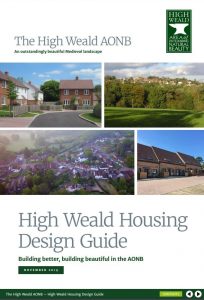The High Weald AONB Design Guide was adopted by Rother District Council on 11 Feb 2020. The on-line edition is dated November 2019. 44pp.
The fifteen councils took two years to collate how they would like to see the design of houses appear in this huge AONB. Generally they have succeeded with a review of all matters regarding topics such as ‘the right built form’, ‘connecting beyond the site’, structuring and parking. The 45pp is filled with photographs of typical Wealden buildings the design of which is to inspire, inform and to follow, also with photographs of how not to do it – new buildings which the Weald will have to live with for decades to come. Quite how all the new designs with twiterns, cat-slide roofs and open landscape gardens can be successfully and sensitively integrated into the already busy environment is down to planning regulation. No laws and Acts are mentioned to support their admirable appeal. The recommendations are all based on the Design Council’s Guide ‘Building for Life 12’ (it is ‘broadly based on’), the NPPF (2019), Guidance and the National Design Guide, and LEMPs. They would like a lot of work on the planning of new sites to be sorted out Design and Access Statements. ‘Ongoing management proposals for the open space and habitats should be included up front as part of the planning application as part of a Landscape and Ecological Management Plan.’ In a nod to biodiversity metrics which are being slowly introduced, they state that ‘The wildlife of the High Weald is embedded in the landscape character and so proposals for habitat creation and enhancements or biodiversity net gain should also be able to make positive contributions to landscape character.’ There is a great deal of ‘should’ do this (252 mentions) as opposed to ‘must’ (13), which goes against the grain of BS42020 2016. There is plenty of emphasis on ‘multi-function green spaces’ ‘incorporating drainage systems within green space’ with illustrations of a suitable example (so watch where you are treading – the new open green spaces may have some watery surprises. Generally the idea to ‘enhance habitats and wildlife’ is plausible, and ‘opportunities for wildlife should be maximised’ are maxims that have been trotted out over the years, and there is nothing tangible for developers to grasp other than their usual suite of bat, bird, hedgehog boxes, log piles etc. When metrics are eventually obligatory then more positive habitat creation will be obligatory on or off site, and the Weald will benefit accordingly. However, that day is slow to arrive. In the meantime, readers are directed to the Wildlife Trusts’ ‘Homes, People and Wildlife’ for further advice and inspiration.
